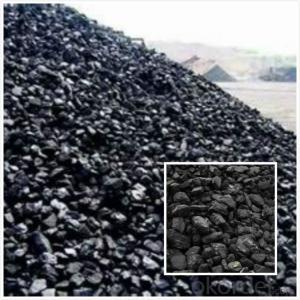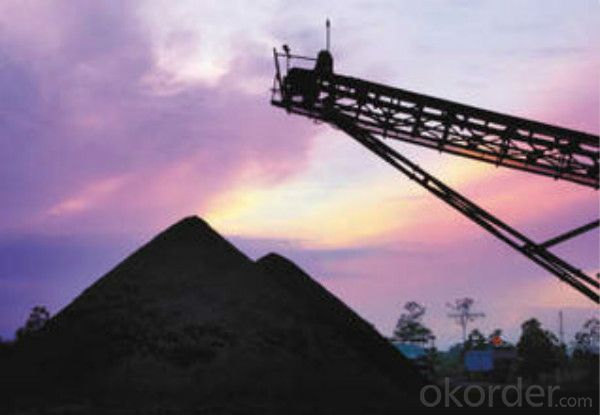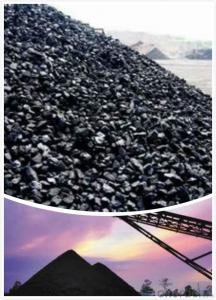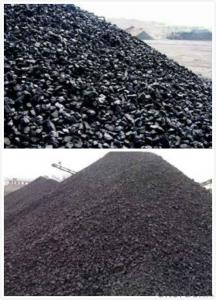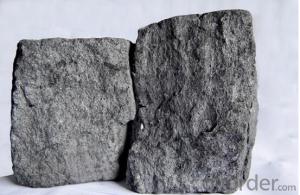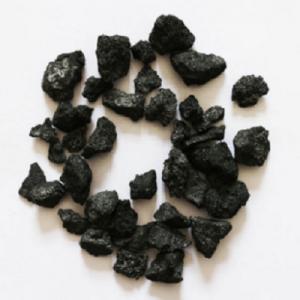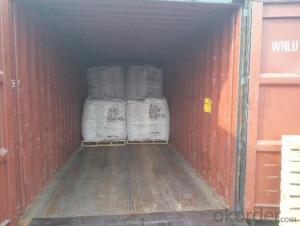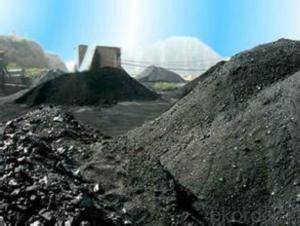Foundry Coke Manufactured in China in High Quality
- Loading Port:
- Tianjin
- Payment Terms:
- TT OR LC
- Min Order Qty:
- 800 m.t
- Supply Capability:
- 12000 m.t/month
OKorder Service Pledge
OKorder Financial Service
You Might Also Like
Product Description
Foundry Coke is a kind of main raw materials used for steel making, we have own coke plants at Shanxi province with output 2 million MT.
The coke handled by our couporation is made from superior coking coal of Shanxi province. Provided with the dvantages of low ash, low sulphur and high carbon.Our coke is well sold in European,American,Japanese and South-east Asian markets.
Features
This is a special coke that is used in furnaces to produce cast and ductile iron products. It is a source of heat and also helps maintain the required carbon content of the metal product. Foundry coke production requires lower temperatures and longer times than blast furnace coke.
Specification
Fixed Carbon | Sulphur Content | Moisture | V.Matter | Ash |
86%min | 0.7%max | 5%max | 1.2%max | 12%max |
88%min | 0.65%max | 5%max | 1.5%max | 10%max |
85%min | 0.8%max | 15%max | 2%max | 13.5%max |
Size: 60-90mm,90-120mm,120-150mm,150-180mm and so on.
Pictures


FAQ:
1 How long can we deliver the cargo?
Within 30 days after receiving the LC draft or down payment
2 Time for after-sales?
1 year.
3 Cutomized or general specfications?
Both
- Q: What are the advantages and disadvantages of carbon monoxide and carbon dioxide?
- But traditional carbon monoxide inhalation has the risk of poisoning patients and medical staff by accidental inhalation of high doses of carbon monoxide. That's the advantage. Carbon dioxide is an essential ingredient in plant photosynthesis, and its increase in content is beneficial to the growth of plants. Carbon dioxide can be used as fertilizer to grow crops in greenhouse vegetables. In addition, carbon dioxide can be used as a source of oxygen in diving and aviation. Liquid carbon dioxide has a broad application prospect, the liquid carbon dioxide as extraction medium of naturally occurring compounds from certain plants or plant sources, not only does not damage the bioactive substances contained in the raw material, and the product does not contain residual medium, method for spraying liquid carbon dioxide to the airport in two fog, mist removal efficiency of hundreds of times higher than that of solid carbon dioxide.
- Q: What is the density of carbon steel and alloy steel?
- Manganese steel 7.8115CrA 7.74 steel20Cr, 30Cr, 40Cr steel, 7.8238CrA 7.80 steelChromium vanadium, chromium nickel, chromium nickel molybdenum, chromium, manganese, silicon, manganese, nickel chromium manganese silicon silicon steel 7.85Chromium nickel tungsten steel 7.80
- Q: How does carbon impact the prevalence of wildfires?
- Carbon impacts the prevalence of wildfires in several ways. First, carbon dioxide (CO2) is a greenhouse gas that contributes to climate change. As concentrations of CO2 increase in the atmosphere, temperatures rise, leading to drier conditions in many regions. These dry conditions create a more favorable environment for wildfires to ignite and spread. Furthermore, carbon plays a significant role in the fuel load that can feed wildfires. Carbon-based materials, such as dead vegetation, trees, and other organic matter, serve as the primary fuel source for fires. As carbon accumulates in ecosystems, either through natural processes or human activities like deforestation, the amount of potential fuel for wildfires increases. This elevated fuel load can result in more frequent and intense fires. Additionally, carbon impacts the health and vitality of forests. Elevated levels of atmospheric CO2 can enhance plant growth, leading to denser vegetation. While this may seem beneficial, it can actually contribute to the intensity and severity of wildfires. Denser vegetation creates a greater amount of fuel, and when combined with the dry conditions caused by climate change, it becomes a recipe for more destructive fires. Lastly, the combustion of carbon-based materials during wildfires releases large amounts of carbon dioxide into the atmosphere. This creates a positive feedback loop, as the increased carbon emissions contribute to further climate change, which in turn exacerbates the conditions for wildfires. Overall, carbon plays a crucial role in shaping the prevalence and severity of wildfires through its impact on climate change, fuel load, forest health, and the release of greenhouse gases during combustion. Addressing carbon emissions and implementing effective forest management practices are essential in mitigating the risks and impacts associated with wildfires.
- Q: What are greenhouse gases?
- Greenhouse gases, which encompass carbon dioxide (CO2), methane (CH4), nitrous oxide (N2O), and fluorinated gases, have the capability to trap heat within the Earth's atmosphere, thus contributing to the phenomenon known as the greenhouse effect. These gases occur naturally and are additionally released into the atmosphere through human activities such as the combustion of fossil fuels, deforestation, and industrial processes. The greenhouse effect plays a crucial role in maintaining the Earth's temperature at a level that supports life. Nevertheless, the excessive release of greenhouse gases has disrupted the atmospheric balance, resulting in global warming and climate change. It is imperative to reduce the emission of greenhouse gases and discover sustainable alternatives to alleviate the detrimental impacts these gases have on our planet.
- Q: What are the advantages of carbon-based solar cells?
- The advantages of carbon-based solar cells include their low cost and abundance of raw materials, as carbon is a widely available element. They also exhibit high efficiency and can be flexible, lightweight, and transparent, allowing for diverse applications. Additionally, carbon-based solar cells have a low environmental impact and can be easily manufactured using scalable techniques.
- Q: What is the symbol for carbon?
- The symbol for carbon is "C".
- Q: What is carbon fixation?
- Carbon fixation is the process by which carbon dioxide from the atmosphere is converted into organic compounds, primarily through photosynthesis in plants.
- Q: How does carbon impact the energy balance of the Earth?
- Carbon impacts the energy balance of the Earth primarily through its role in the greenhouse effect. Carbon dioxide (CO2), a greenhouse gas, is released into the atmosphere through natural processes and human activities such as burning fossil fuels and deforestation. The greenhouse effect is a natural process where certain gases in the atmosphere trap heat from the sun, preventing it from escaping back into space. This process helps maintain a suitable temperature for life on Earth. However, excessive carbon emissions have enhanced the greenhouse effect, leading to global warming and climate change. When carbon dioxide and other greenhouse gases accumulate in the atmosphere, they trap more heat, causing the Earth's surface temperature to rise. This rise in temperature disrupts the energy balance of the planet. It contributes to the melting of polar ice caps, rising sea levels, and more frequent and severe extreme weather events. Furthermore, carbon affects the energy balance of the Earth by altering the carbon cycle. The carbon cycle is a natural process in which carbon is exchanged between the atmosphere, oceans, and land. However, human activities have significantly disrupted this cycle by releasing large amounts of carbon into the atmosphere, primarily through the burning of fossil fuels. Excessive carbon emissions result in an imbalance in the carbon cycle, as the natural processes that absorb and store carbon, such as photosynthesis and the ocean's ability to absorb CO2, cannot keep up with the pace of emissions. This leads to an accumulation of carbon dioxide in the atmosphere, further exacerbating the greenhouse effect and contributing to global warming. Overall, carbon significantly impacts the energy balance of the Earth by intensifying the greenhouse effect and disrupting the natural carbon cycle. It is crucial to reduce carbon emissions and transition to cleaner and more sustainable energy sources to mitigate the negative effects of carbon on the planet's energy balance and ultimately, preserve the health and stability of our environment.
- Q: How does carbon impact the global water cycle?
- Carbon can have a significant impact on the global water cycle through various processes. One major way carbon affects the water cycle is through the process of photosynthesis. Plants and trees take in carbon dioxide from the atmosphere during photosynthesis and convert it into oxygen and glucose. This process not only helps in the carbon cycle but also plays a crucial role in the water cycle. During photosynthesis, plants release water vapor into the atmosphere through tiny pores called stomata. This water vapor contributes to the overall humidity in the atmosphere, leading to an increase in cloud formation. Clouds, in turn, play a crucial role in the water cycle as they contain condensed water droplets that eventually fall as precipitation. Additionally, carbon dioxide is a greenhouse gas that contributes to global warming and climate change. As the Earth's temperature rises due to increased levels of carbon dioxide, the water cycle is also affected. Warmer temperatures can lead to increased evaporation rates, causing more water to evaporate from oceans, rivers, and lakes. This excess moisture in the atmosphere can result in more intense rainfall events, leading to floods and other extreme weather events. Furthermore, carbon dioxide can impact the acidity of water bodies. When carbon dioxide dissolves in water, it forms carbonic acid, which can lower the pH of the water. This process, known as ocean acidification, can have detrimental effects on marine life, particularly organisms that rely on calcium carbonate for their shells and skeletons. These impacts can disrupt the balance of ecosystems and have long-term consequences for the health and functioning of the global water cycle. In summary, carbon has a profound impact on the global water cycle through processes such as photosynthesis, greenhouse gas emissions, and ocean acidification. Understanding these interactions is crucial for managing the effects of carbon on the environment and ensuring the sustainability of the water cycle.
- Q: What is the structure of graphite, another form of carbon?
- Graphite possesses a unique carbon form with a structure that differs from diamond or amorphous carbon. It showcases layers of carbon atoms arranged in a hexagonal lattice. Covalent bonds connect each carbon atom to three neighboring carbon atoms, resulting in a two-dimensional sheet-like structure. Within each layer, the carbon atoms bond together through robust covalent bonds, creating a flat network. The carbon-carbon bonds in graphite are notably stronger than typical single bonds, ensuring the structure's high stability. The hexagonal lattice arrangement of carbon atoms forms a honeycomb-like pattern, giving graphite its characteristic appearance. The layers in graphite remain cohesive due to weak van der Waals forces, enabling easy sliding between them. This attribute grants graphite its lubricating properties and allows it to leave marks on paper when used as a pencil lead. Additionally, the arrangement of carbon atoms in graphite contributes to its exceptional electrical conductivity. The structure's delocalized electrons can move freely along the layers, facilitating the flow of electric current. This feature renders graphite valuable in various applications, including electrical components, electrodes, and as a lubricant in high-temperature environments. In conclusion, graphite's structure comprises layers of carbon atoms organized in a hexagonal lattice. These layers are bonded through strong covalent bonds within each layer and held together by weak van der Waals forces. This distinctive structure grants graphite its unique properties, such as its lubricating nature, electrical conductivity, and versatility in diverse industrial applications.
Send your message to us
Foundry Coke Manufactured in China in High Quality
- Loading Port:
- Tianjin
- Payment Terms:
- TT OR LC
- Min Order Qty:
- 800 m.t
- Supply Capability:
- 12000 m.t/month
OKorder Service Pledge
OKorder Financial Service
Similar products
Hot products
Hot Searches
